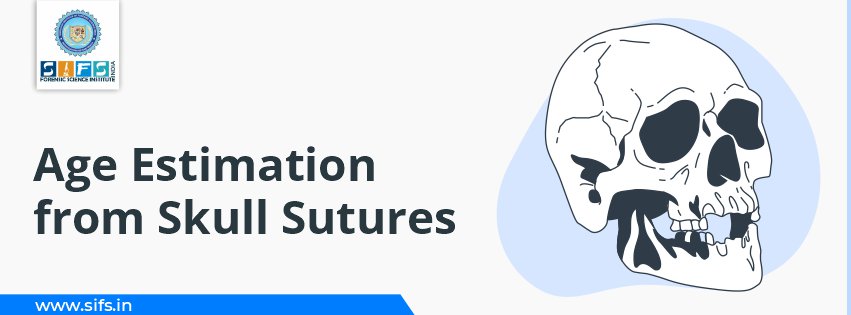- Call Us: +91 7303913002
- Email Us: education@sifs.in
Age Estimation from Skull Sutures

BY SIFS India | January 12, 2025
Age Estimation from Skull Sutures
In the field of forensic anthropology, the identification of unidentified bodies is a very essential task.
Forensic anthropology is the scientific study of human skeletal remains and skulls for law enforcement agencies which is helpful in estimation of age, sex, race, stature and time since death.
Forensic anthropologists examine the physical features such as birthmarks, scars, tattoos and biological parameters of the skeleton remain to determine past trauma like broken bones or medical procedures as well as diseases related to bone cancer.
There are several putrefied dead, disputed burners, and mutilated bodies that make it difficult to identify an individual. Anthropologists used to examine the bones which is helpful in identifying the dead remains when other physical evidence no longer exists.
In the field of forensic science, forensic anthropologists play a crucial role in a death investigation.
They use many aspects for the identification of skeleton remains by identifying long bones, eruption sequence of teeth, sex determination from pelvis, skull and mandible, age estimation from skull suture, Gustafson method.
In this article, we will study the estimation of age from a skull suture.
The more accurate estimation is done from sagittal suture, lambdoid suture and then coronal suture. Cranial sutures fuse progressively with the increasing age of the individual.
Skull Sutures
Sutures are the immovable and fibrous joints which are present between the skull bones.
They are analogous to the epiphyseal and diaphyseal junction of long bones because they are the fibrous locus of joint and centre of growth.
The important fact about the sutures is, that they control the separation of the bones when any external forces are applied to it as muscle function or trauma. They help to allow movement between bones at the time of rapid growth of cephalic viscera.
According to modified Lobb’s classification, there are three sets of sutures that are considered for the estimation of the age of an individual.
1. Suture of the vault
2. Circummeatal suture
3. Accessory suture
1) Sutures of the Vault
- Coronal Suture: Coronal suture is located in between the frontal and parietal bones of the skull. It separates the 2 parietal bones from the frontal bone. At the time of birth, this suture decreases in size and allows the skull to become smaller. It begins ossification at the age of 30-35 years and becomes fully ossified at 55-60 years.
- Sagittal Suture: The sagittal suture is a dense, fibrous tissue that connects the two parietal bones of the skull. It is also known as interparietal and sutura interparietal. The bregma and vertex are the two structural sites at this suture. The suture starts at the age of 20 and joins at the age of 35.
- Lambdoid Suture: It is a dense, fibrous connective tissue joint present on the backside of the skull which connects the 2 parietal bones with the occipital bone. It starts ossifying at 30-35 years and becomes fully fused by 60-70 years.
2) Circummeatal Suture
Sutures present around the ear canal and this include-
- Squamous or Temporal Suture: This suture connects the temporal squamous with the lower portion of the parietal bone. It begins the ossification by the age of 30-35 years and is completely fused at the age of 60-65 years.
- Spheno-Temporal Suture: This suture is present between the sphenoid bone and temporal bone. It begins the ossification by the age of 30-35 years and the ossification is completed by 60-65 years.
- Parietal-Mastoid Suture: This suture is present between the parietal bone and mastoid portion of the temporal bone. It begins with ossification by 30-40 years and the ossification is completed by 75-80 years. It is the last suture to fuse.
- Occipital-Mastoid Suture: This suture is present between the occipital bone and the mastoid portion of the temporal bone. It begins the ossification by the age of 25-30 years and is completed by 65-70 years.
3) Accessory Suture
These are the suture that can’t be classified as sutures of the vault and Circummeatal sutures.
- Spheno-Parietal Suture: This suture is present between the sphenoid bone and the parietal bone. It begins ossification by the age of 25-30 years and the ossification is completed by 60-65 years.
- Spheno-Frontal Suture: This suture is present between the sphenoid bone and the parietal bone. It begins the ossification by 25-30 years and is completely fused by 60-70 years.
Other than these sutures there are 3 more sutures that are considered to determine the age of an individual which are-
- Metopic Suture: Metopic suture is also known as a frontal, interfrontal or median frontal suture. The frontal bone is parted by a metopic suture which is present in newborn babies. this suture is fused between 2-3 years of age.
- Mandible Suture: Mandible suture is present between the two halves of the mandible. The suture fuse by the age of 2-3 years.
- Basispenoid Suture: This suture is present at the basal part of the occipital bone and the sphenoid bone. This suture fuse at puberty by the age of 16-20 years.
Conclusion
Sutures are the most essential parts of the skull of the human body for the identification of individuals and skeleton remains when there is no other factor exists.
In case of mass disaster, mutilated bodies, burnt bodies, or putrefied bodies, it is difficult for the investigator to identify the dead remains when no other biological factor or physical evidence is found.
Then cranial sutures play a significant role in identifying the unidentified body.
Sutures are extensively fused to increase the age of the person and give specificity to the age of that individual. Each suture fuses with a particular age.
Written by: Tanu Sindhvani

